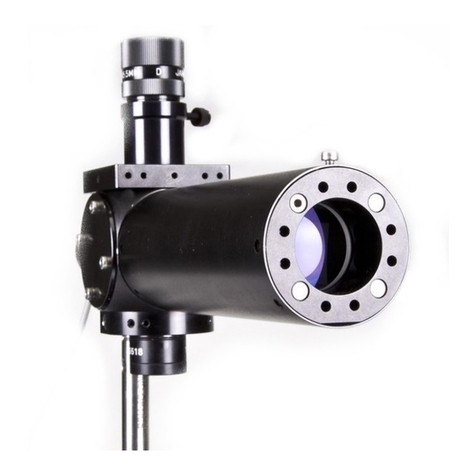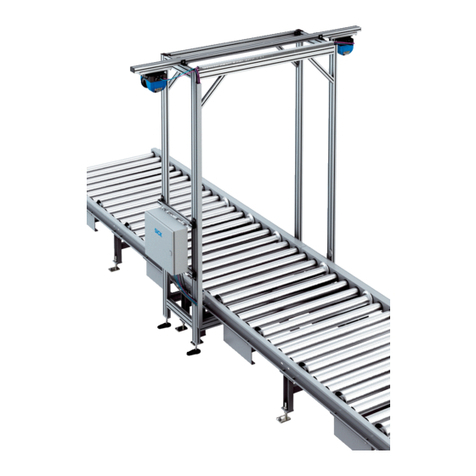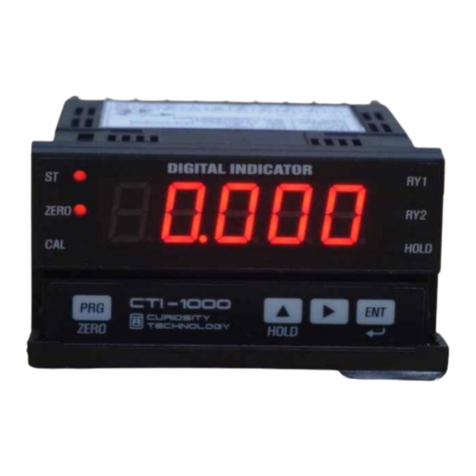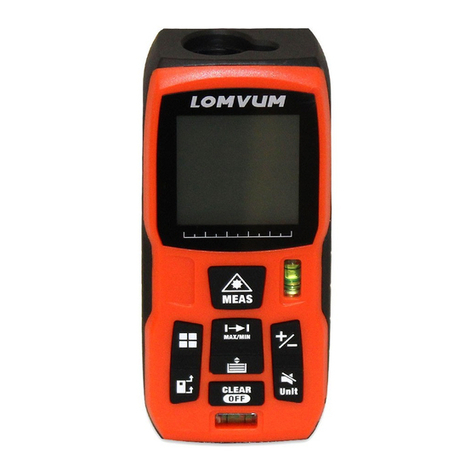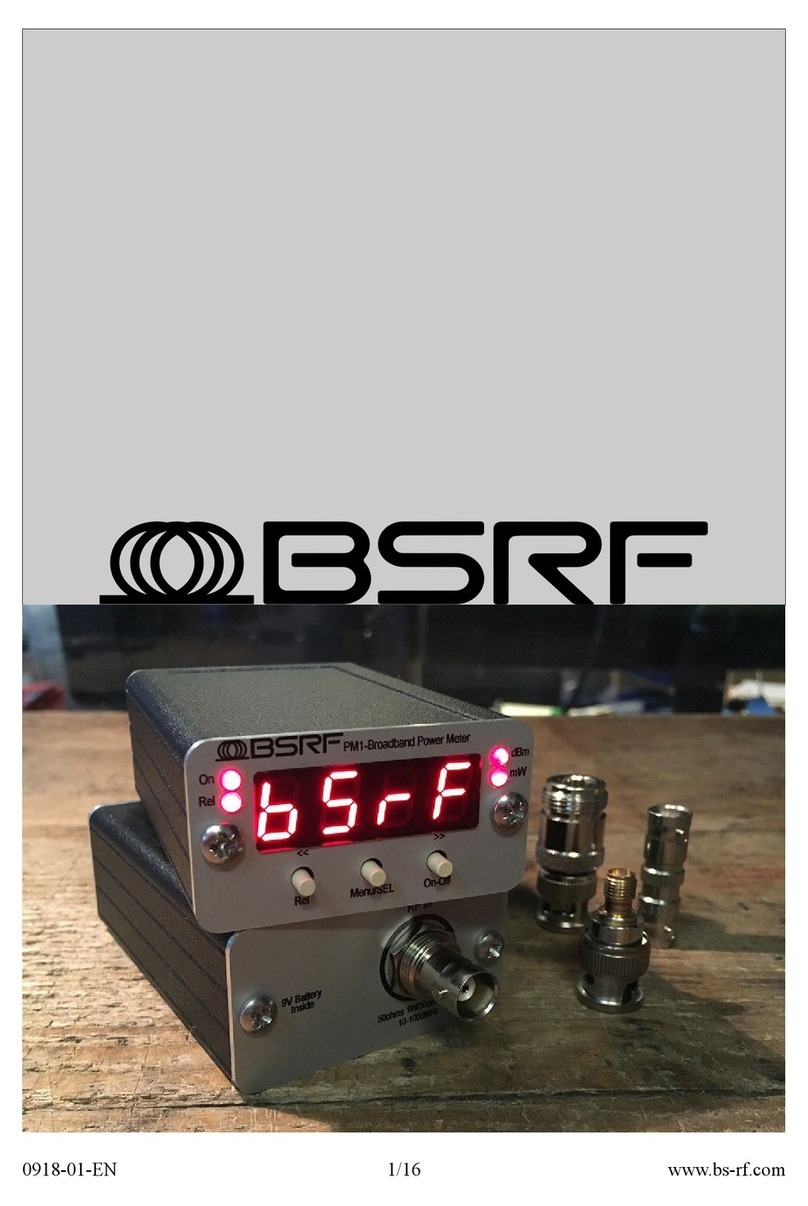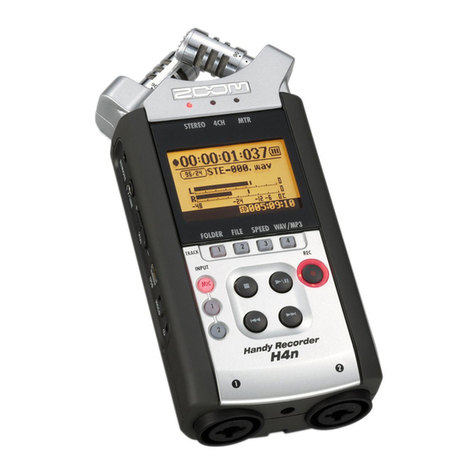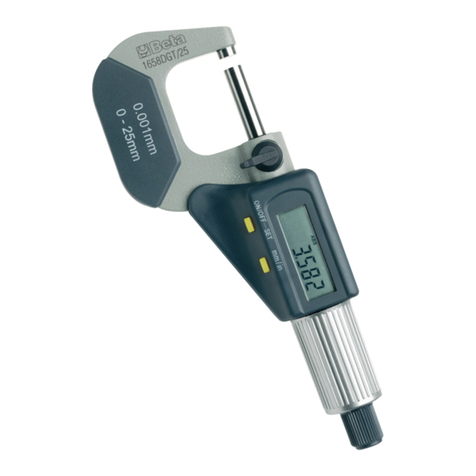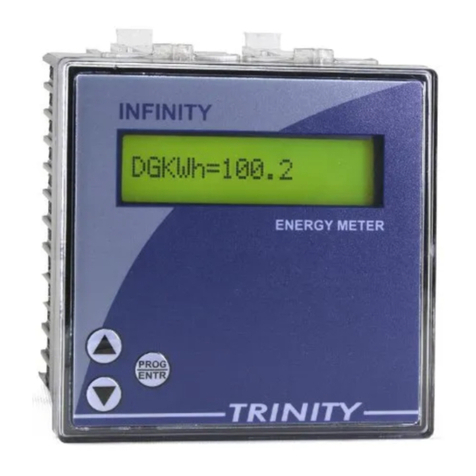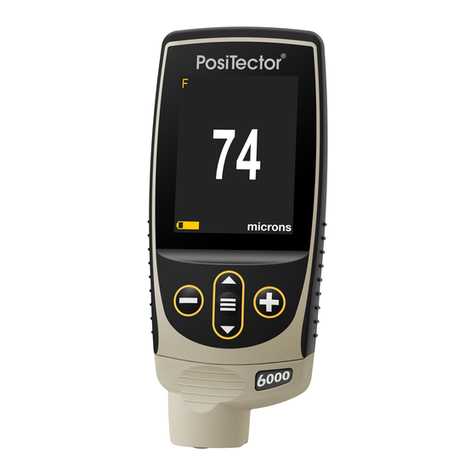Edmund Optics 89-307 User manual

USB Power Meter - User Manual Revision 17.0 i

USB Power Meter - User Manual Revision 17.0 ii
WARRANTY
The Edmund Optics USB POWER METER Single Channel Laser Power/Energy Meter carries a one-year
warranty (from date of shipment) against material and/or workmanship defects when used under normal
operating conditions. The warranty does not cover recalibration, or damages related to misuse.
Edmund Optics will repair or replace at our option any USB POWER METER which proves to be defective
during the warranty period; except in the case of product misuse.
Any unauthorized alteration or repair of the product is also not covered by the warranty.
The manufacturer is not liable for consequential damages of any kind.
In the case of a malfunction, contact your local Edmund Optics distributor or the nearest Edmund Optics office to
obtain a return authorization number. Return the material to the appropriate address below.
Contacting Edmund Optics
To help us answer your calls more efficiently please have the model number of the detector you are using ready
before calling Customer Support.
Edmund Optics, Inc
101 E. Gloucester Pike
Barrington, NJ 08007
P: 1-800-363-1992
F: 1-856-573-6295
Web: www.edmundoptics.com
CLAIMS
To obtain warranty service, contact your nearest Edmund Optics agent or send the product, with a description of
the problem, transportation and insurance prepaid, to the nearest Edmund Optics agent. Edmund Optics
assumes no risk for the damage in transit. Edmund Optics will, at its option, repair or replace the defective
product free of charge or refund your purchase price. However, if Edmund Optics determines that the failure is
caused by misuse, alterations, accident or abnormal condition of operation or handling, you will be billed for the
repair and the repaired product will be returned to you, transportation prepaid.

USB Power Meter - User Manual Revision 17.0 iii
SAFETY INFORMATION
Do not use the USB POWER METER if the device or the detector looks damaged, or if you suspect that the USB
POWER METER is not operating properly.
Appropriate installation must be done for water-cooled and fan-cooled detectors. Refer to the specific
instructions for more information. The user must wait for a while before handling these detectors after power is
applied. Surfaces of the detectors get very hot and there is a risk of injury if they are not allowed to cool down.
Note: This equipment has been tested and found to comply with the limits for a Class A digital device,
pursuant to part 15 of the FCC Rules. These limits are designed to provide reasonable
protection against harmful interference when the equipment is operated in a commercial
environment. This equipment generates, uses, and can radiate radio frequency energy and, if
not installed and used in accordance with the instruction manual, may cause harmful
interference to radio communications. Operation of this equipment in a residential area is likely
to cause harmful interference in which case the user will be required to correct the interference
at his own expense.
Caution: Changes or modifications not expressly approved in writing by Edmund Optics may void the
user’s authority to operate this equipment.
SYMBOLS
The following international symbols are used in this manual:
Refer to the manual for specific Warning or Caution information to avoid any damage to
the product.
DC, Direct Current

USB Power Meter - User Manual Revision 17.0 iv
TABLE OF CONTENTS
TABLE OF CONTENTS ........................................................................................................... 4
1.USB POWER METER Single Channel Laser Power Meter .......................................... 1
1.1.Introduction .................................................................................................................................................1
1.2.Specifications .............................................................................................................................................2
1.3.Front Panel Description ..............................................................................................................................3
2.Operating Instructions .................................................................................................. 5
2.1.Installing the USB Drivers ..........................................................................................................................5
2.2.Quick Measurement Procedure .................................................................................................................6
2.3.Using the USB POWER METER with PC-PREMIER ................................................................................7
3.Serial Communication ................................................................................................... 8
3.1.Serial Commands .......................................................................................................................................8
3.2.Error Messages ........................................................................................................................................10
3.3.Communication Settings ..........................................................................................................................10
4.Declaration of Conformity ........................................................................................... 11
Appendix A – WEEE Directive ............................................................................................. 12

USB POWER METER User Manual Revision 17.0 1
1. USB POWER METER SINGLE CHANNEL LASER POWER METER
1.1. INTRODUCTION
To obtain the full performance from the USB POWER METER, we recommend that you read this manual
carefully.
The USB POWER METER is a microprocessor-based power and energy meter that uses the latest
technology to provide a multitude of options in a user-friendly environment. It is a complete power meter,
which can provide a statistical analysis of your measurements. Moreover, it can be updated over the
internet by connecting the USB or the RS-232 port to a personal computer.
The USB POWER METER USB version and the RS-232 version have enhanced network capabilities that
take further advantage of the USB or RS-232 ports for data acquisition and remote control depending on
the USB POWER METER version. It can transfer data files to a PC for more sophisticated data analysis
and respond to commands through the PC interface. Although the default measurement unit is Watt, you
may also choose to measure in dBm.
Easy software upgrade
Keep in touch with the latest improvements to our user-friendly software. You can download the latest
software version anytime from our website and install it on your PC.

USB POWER METER User Manual Revision 17.0 2
1.2. SPECIFICATIONS
The following specifications are based on a one-year calibration cycle, an operating temperature of 18 to
28ºC (64 to 82ºF) and a relative humidity not exceeding 80%.
Specifications are subject to change without notice
1 Varies with the detector
2 Including linearity
USB POWER METER
Power Meter Specifications
Power Range 1 nW to 10 kW
Physical Scale 2 V, 15 mV
Virtual Power Scales
(Photo Detector)
3 nW, 10 nW, 30nW, 100 nW, 300 nW, 1 µW, 3 µW, 10 µW,
30 µW, 100 µW, 300 µW, 1 mW, 3 mW, 10 mW, 30 mW, 100 mW,
300 mW, 1 W, 3 W
Virtual Power Scales
(Thermopile Detector)
300 µW, 1 mW, 3 mW, 10 mW, 30 mW, 100 mW, 300 mW, 1 W,
3 W, 10 W, 30 W, 100 W, 300 W, 1 kW, 3 kW, 10 kW
Resolution (Digital) Physical scale/8 388 608
Monitor Accuracy ± 0.5%, ± 5µV
Response Time (Accelerated)1 1 sec
Sampling Frequency 10 Hz
Statistics Current value, Max, Min, Average, Std Dev., RMS stability, PTP
stability, Time
Energy Meter Specifications (Energy Mode)
Energy Range 3 mJ to 20 kJ
Virtual Energy Scales 3 mJ, 10 mJ, 30 mJ, 100 mJ, 300 mJ, 1 J, 3 J, 10 J, 30 J, 100 J,
300 J, 1 kJ, 3 kJ, 10 kJ, 30 kJ
Resolution (Digital) 2 nV
Accuracy2 1.0%
Default Trigger Level 250 mJ
Software Trigger Level User Defined in Joules
Repetition Frequency Supports all energy mode power heads
Statistics Current value, Max, Min, Average, Std Dev., RMS stability, PTP
stability, Repetition Rate, Avg Power
General Specifications
Display Rate 3Hz numeric display
10 Hz graphic displays
Data Displays Real-time, Histogram, Tuning Needle, Statistics,
User Input Correction Factors 1 multiplier and 1 offset (7 digit floating point)
Analog Output 0 – 2.05 Volt user defined, full scale, ± 1%
Internet Upgrades USB or RS-232
PC Serial Commands USB or RS-232
Dimensions (without stand) 91 (L) x 57 (W) x 26 max (H) mm
Weight 0.12 kg
External Power Supply (for RS-232
version
Input: 100/240 VAC 50-60 Hz, Output 9-12 VDC 100mA

USB POWER METER User Manual Revision 17.0 3
1.3. FRONT PANEL DESCRIPTION
Figure 1 USB POWER METER Top Panel
EXTERNAL POWER SUPPLY INPUT JACK
Input voltage required: 9-12 VDC/100 mA.
Note: The external power supply input is provided only for the USB POWER METER with the
RS-232 Serial Connection Option.
CAUTION
Permanent damage may occur to the optical meter if an external power supply other than
the Edmund Optics 200130, 200960, SPU15A-105 or SPU15A-104 is used. Please call
Edmund Optics or your local distributor if extra power supplies are needed for a
particular setup.
USB INTERFACE CONNECTOR
This interface allows remote control and data transfers between the USB POWER METER and a
computer that has a USB communication port. With the RS-232 USB POWER METER, this
connector is use as a RS-232 com port.

USB POWER METER User Manual Revision 17.0 4
ANALOG OUTPUT
For monitoring laser average power or energy by using external equipment such as a chart
recorder, a computer with an analog interface, a voltmeter, etc.
The output signal represents a DC analog voltage proportional to the amplified and anticipated
power detector response in the case of a power measurement. In the case of an energy
measurement (energy mode), the output signal is a DC voltage representing the pulse energy
value.
The user must enter the maximum value in the Settings SET Max Analog Out Range. This
value is the value at which the analog output equals 2.05 V. That provides the best signal-to-
noise ratio. The measured power or energy is then related to the output voltage and to the
selected range according to the following equations:
V
out
= Measurement * 2.05 / Max Analog Out Range
For example, with a 10 W max analog range:
2.05 V corresponds to 10 W
1.025 V corresponds to 5 W
Another useful example: To set the analog output so that 1V corresponds to a measurement of
56W, the Max Analog Out Range must be set to 20.5 according to the following equation:
Max Analog Out Range = 56 * 2.05
Specifications on the analog output:
Maximum output voltage: 2.05 V
Output impedance: 274
Connector type: Female 1/8” jack
PROBE INPUT JACK
The USB POWER METER uses a DB-15 female connector to mate with the detector heads
(probes).
The USB POWER METER works with all Edmund Optics power detectors. It automatically
recognizes every power detector head, which ensures accurate auto-calibration. More
importantly, it can take advantage of our Personal wavelength correction™. It reads the memory
in the Smart Interface connector (version 5 and higher) to provide a wavelength correction that is
based on spectral data measured from that specific detector.
The USB POWER METER may not recognize some of the earlier heads.
WARNING
This DB-15 connector, though similar to that of the former TPM-310 and TPM-330
monitors, is incompatible with the power detector heads of PS-310 Series Version 1 and
PS-330 Series Version 1. These heads used a different technology and do not have the
same pin-out configuration.
The Edmund Optics C-300 adaptor can be used in order to connect the power detector heads of
PS-310 Series and PS-330 Series Version 1 and 2. Please contact your local Edmund Optics
distributor or the nearest Edmund Optics office for further information.
Any attempt to modify connectors of the early version heads to mate with the USB POWER
METER can result in damage to the monitor.

USB POWER METER User Manual Revision 17.0 5
2. OPERATING INSTRUCTIONS
First, you have to install the PC-PREMIER software on your computer, along with the USB drivers. Please
find the latest version on our website. The software will automatically connect to the first COM port
available. As soon as you are connected, you are ready to adjust the settings (please refer to the PC-
PREMIER manual).
2.1. INSTALLING THE USB DRIVERS
Plug the USB POWER METER into a USB port on the PC. If the PC supports USB 1.1, Windows detects
the new device and prompts you for the software drivers. A window will open that says “Found New
Hardware – USB Device” and after a few moments, the “Found New Hardware Wizard” will appear.
The USB drivers are available on our website.
Please note that old monitors without the (R2) at the end of the product name need different USB drivers
which are available on our website also. They do not support Windows VISTA, unless noted on the
website.
At the end of this process, a new serial COM port will be added to the list of communication ports. It may
be used as any other serial port. You will need to know the COM port number to set up the serial
connection to the USB POWER METER.
Verify COM Port
To verify the USB installation and find the COM port number, open the device manager and scroll down
to Ports (COM & LPT) and double click that line. One of the options should be:
USB-to-Serial Port (COM#)
Note the COM port number, you will need it for the next step.

USB POWER METER User Manual Revision 17.0 6
2.2. QUICK MEASUREMENT PROCEDURE
This section shows you the fastest way of making a laser power measurement with the USB POWER
METER.
The monitor automatically recognizes all the Edmund power heads of version 4 or higher. All custom
technical data required for optimum operation of the detector will be automatically downloaded from the
EEPROM in the DB-15 connector. This data includes sensitivity, model, serial number, version,
wavelength correction factors, and time response. In case of a conflict, use the sensitivity on the most
recent calibration certificate. The USB POWER METER must be disconnected from the PC before
connecting a new head in order to prevent any lost of data from the detector’s head EEPROM.
1 Install the power detector head on its optical stand.
2 First, slide the connector latch to the right to unlock the connector.
3 Connect a version 5 (or higher) power or energy detector head to the USB POWER METER
using the PROBE INPUT JACK while the USB POWER METER is disconnected from the PC.
4 Slide the latch to the left to lock the connector into place.
5 Connect the USB cable to your computer for the USB model or, for model RS-232, plug the
RS-232 cable to your computer and then the power supply.
6 Open PC-PREMIER and click on the Connect button in the Ribbon menu.
7 If you have a photodiode, to obtain measurements in dBm, select Measure Mode / dBm.
Adjust the Zero (Steps 8 to 10)
8 Remove the head’s protective cover.
Put the detector head into the laser beam path. The entire laser beam must be within the
sensor aperture. Do not exceed maximum specified densities or powers. For the most
accurate measurement, spread the beam across 60% to 80% of the sensor area.
Note: Power heads can be used with both CW and pulsed lasers.
9 Block off the laser radiation to the detector.
10 The power read by the USB POWER METER when no laser beam is incident on the detector
may not be exactly zero. This is because the detector is not thermally stabilized OR there was
a heat source in the detector’s field of view when you turned on the USB POWER METER.
11 To reset the zero, wait until the reading has stabilized and select Zero Offset button in the
Ribbon menu. Note that the Zero Offset process can take about 20s for a photodiode. It is
much quicker for other detectors. You are now ready to make an accurate measurement.
Notes:
Refer to specific power detector documentation for complete installation and operating
instructions.
The power detectors are thermal sensors sensitive to temperature variations.
For high-precision measurements, it is recommended to:
Allow the power detector temperature to stabilize before zeroing the USB POWER
METER.
Do not touch the detector head when handling the power detector. Touch only the stand.
Avoid forced airflow or drafts around the detector.
12 Apply the laser beam to the detector head.
13 The laser beam average power will be displayed in three ways for your convenience:
Digitally for real time measure.
On a histogram to allow the laser beam’s long-term stability to be evaluated.
On a digital needle for laser tuning.

USB POWER METER User Manual Revision 17.0 7
2.3. USING THE USB POWER METER WITH PC-PREMIER
The PC-PREMIER is a user-friendly communication software specially made for Edmund Optics monitors,
including the USB POWER METER (USB and RS-232). It is available for free through our website. The
PC-PREMIER lets you control, visualize and save the monitor’s and detector’s information, while saving
data.
You can download the PC-PREMIER program. Access our website and go to the Downloads section.
Click on the file name and download it to your PC. The specific actions necessary vary by browser and
browser settings. After it is transferred, open the file on your PC and follow the instructions to
decompress and install it.
Please refer to the PC-PREMIER manual also available on our website.
If you try to install the same PC-PREMIER version twice on your computer, you will have the following
warning:
Installation Summary:
No software will be installed or removed.
In such a case, please press Enter and continue using the installed version of PC-PREMIER.

USB POWER METER User Manual Revision 17.0 8
3. SERIAL COMMUNICATION
3.1. SERIAL COMMANDS
The star(*) is part of each command
Commands Description Return Example
*ATT Turns the attenuator correction ON when available for the
detector
“ACK\r\r\n”
*ATF Turns the attenuator correction OFF. OFF by default. “ACK\r\r\n”
*CAU Sends the data points through the serial port at a frequency of 10
Hz
“9.793354e-01\r\r\n
9.792939e-01\r\r\n”
*CSU Ends the *CAU mode “ACK\r\r\n”
*CVU Returns a single measurement (the current measurement)
through the serial port.
“ACK\r\r\n9.793354e-
01\r\r\n”
*ANT Turns the anticipation ON. ON by default & return characters
« ACK »
“ACK\r\r\n”
*ANF Turns the anticipation OFF “ACK\r\r\n”
*CFT Turns the power correction ON. ON by default. “ACK\r\r\n”
*CFF Turns the power correction OFF “ACK\r\r\n”
*AOB Modifies the analog output voltage value (*AOB + 8 characters)
Example: *AOB1.00E+01 The maximum value of the analog
display (2.05 volts) is 10 watts
“ACK\r\r\n”
*AOD Sets an analog output delay from 1s to 7s for a return to 0V after
an energy measurement. Default 0 (no return to zero after an
energy measurement).
Example: *AOD2.00E+00 The delay is 2 seconds.
“ACK\r\r\n”
*RST Resets the device “”
*SOU Sets the zero offset “ACK\r\r\n”
*KPA Returns the character string « ACK » “ACK\r\r\n”
*PWC Wavelength correction value (+ 5 characters)
Example: *PWC01064 selects the wavelength 1064 nm
“ACK\r\r\n”
*TLC Modifies the trigger level in energy mode (+ 8 characters)
Example: *TLC2.00E-02 selects a Trig Level of 0.002 Joules
“ACK\r\r\n”
*NAM Returns the model of the head to the serial port “UP55N-400W-
H9\r\r\n”
*VER Returns the name of the software to the serial port “Version 1.14\r\r\n”
*F01 Returns information about current status
All field are separate by a TAB character “\t”
“Version\t3\tName\tUP
55N-400W-
H9\tWavelength\t1064
\tTrig
Level\t2.500000e-
01\tMax Analog
Output\t2.047500e+00
\tMode\t0
Offset\t0\tMUL\t1.0000
00e+00\tOFF\t0.00000
0e+00\tPWCStatus
65536\tMinScale\t24\r\
r\n”

USB POWER METER User Manual Revision 17.0 9
*F02 Returns more information about current status
All field are separate by a TAB character “\t”
“Version\t3\tName
\tUP55N-400W-
H9\tWavelength
\t1064\tTrig
Level\t2.500000e-
01\tMax Analog
Output
\t2.047500e+00\tMode
\t0\tOffset\t0\tMUL\t1.0
0000e+00\tOFF\t0.000
000e+00\tPWCStatus\
t65536\tMinScale\t24\t
LinearCorr\t1\tAnticipa
tion\t1\tAttenuator
\t0\r\r\n”
*MUL Modifies the multiplication factor (+ 8 characters)
Example: *MUL1.00E+01 selects a multiplication factor of 10
“ACK\r\r\n”
*OFF Modifies the offset (8 characters)
Example: *OFF-2. 0E-00 selects a user offset of two watts
“ACK\r\r\n”
*CMW Turns the Energy Mode ON “ACK\r\r\n”
*CMX Turns the Energy Mode OFF. OFF by default. “ACK\r\r\n”
*SHI Make a physical scale down. “ACK\r\r\n”
*SLO Make a physical scale up. “ACK\r\r\n”
*FAS Turns the autoscale mode on. “ACK\r\r\n”
Please note that you must type the exact number of characters or numerical values required.
Example: *AOB1.00E+01 has 8 characters/numerical values. Don’t put any space between
characters or numerical values.

USB POWER METER User Manual Revision 17.0 10
3.2. ERROR MESSAGES
“\r\r\nE01\r\r\n” Bad Command
“\r\r\nE02\r\r\n” Energy Mode is not available
“\r\r\nE03\r\r\n“ N/A
“\r\r\nE04\r\r\n“ The selected wavelength correction factor is not valid
“\r\r\nE05\r\r\n” The connector is not connected
“\r\r\nE06\r\r\n” Attenuator not available
3.3. COMMUNICATION SETTINGS
Bits per second 57600
Data bits 8
Parity None
Stop bits 1
Flow control None

USB POWER METER User Manual Revision 17.0 11
4. DECLARATION OF CONFORMITY
Application of Council Directive(s): 2014/30/EU The EMC Directive
Manufacturer’s Name: Gentec Electro Optics, Inc.
Manufacturer’s Address: 445 St-Jean Baptiste, suite 160
(Québec), Canada G2E 5N7
European Representative Name: Laser Components S.A.S.
Representative’s Address: 45 bis Route des Gardes
92190 Meudon (France)
Type of Equipment: Optical Power Monitor
Model No.: P-Link
Year of test & manufacture: 2011
Standard(s) to which Conformity is declared:
EN 61326-1:2006: Emission generic standard
Standard Description Performance Criteria
CISPR 11 :2009
A1 :2010
Industrial, scientific and medical equipment – Radio-
frequency disturbance characteristics – Limits and
methods of measurement
Class A
EN 61000-4-2
2009
Electromagnetic compatibility (EMC) – Part 4-2: Testing
and measurement techniques- Electrostatic discharge.
Class B
EN61000-4-3
2006+A2:2010
Electromagnetic compatibility (EMC) – Part 4-3: Testing
and measurement techniques- Radiated, Radio
Frequency, electromagnetic field immunity test.
Class A
EN61000-4-4
2012
Electromagnetic compatibility (EMC) – Part 4-4: Testing
and measurement techniques- Electrical fast
transient/burst immunity test.
Class B
EN 61000-4-6
2013
Electromagnetic compatibility (EMC) – Part 4-6: Testing
and measurements techniques- Immunity to conducted
Radio Frequency.
Class A
EN 61000-3-
2:2006+A1:2009
Electromagnetic compatibility (EMC) - Part 3-2: Limits -
Limits for harmonic current emissions (equipment input
current <= 16 A per phase)
Class A
I, the undersigned, hereby declare that the equipment specified above
conforms to the above Directive(s) and Standard(s).
Place: Québec (Québec)
Date: July 14, 2016
(President)

USB POWER METER User Manual Revision 17.0 12
APPENDIX A – WEEE DIRECTIVE
Recycling and separation procedure for WEEE directive 2002/96/EC
This section is used by the recycling center when the monitor reaches its end of life. Breaking the
calibration seal or opening the monitor will void the USB POWER METER warranty.
The complete Monitor contains:
1 Monitor
1 power supply for RS-232 option (not made by Edmund Optics).
1 USB cable for USB option.
1 calibration certificate
Separation
Paper: Manual and certificate
Plastic: Monitor side enclosure.
Wires: USB cable and power supply plug.
Printed circuit board: inside the monitor.
Aluminum: Monitor enclosure
Opening the Monitor
Figure 2 Opening the USB POWER METER Monitor

Table of contents
Other Edmund Optics Measuring Instrument manuals
Popular Measuring Instrument manuals by other brands

Ruskin
Ruskin AIRFLOW-IQ Start-up & Commissioning Guide
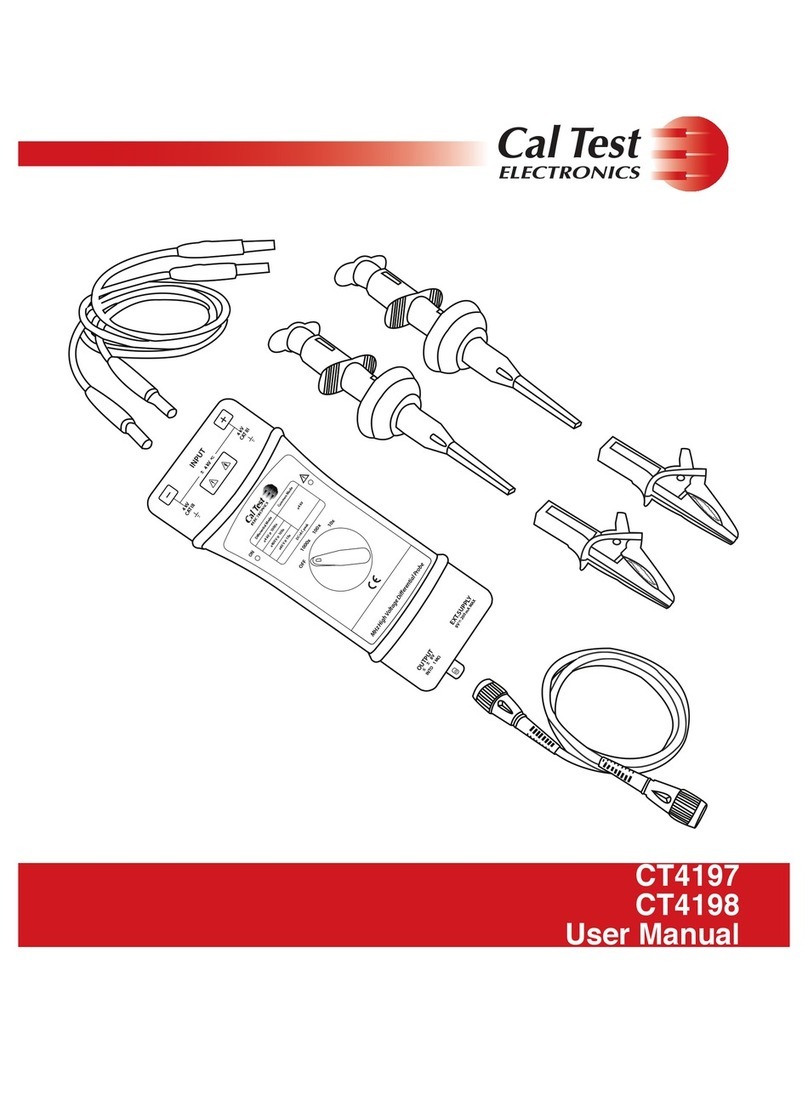
Cal Test Electronics
Cal Test Electronics CT4197 user manual

Panametrics
Panametrics DewPro MMR31 Installation & operation manual
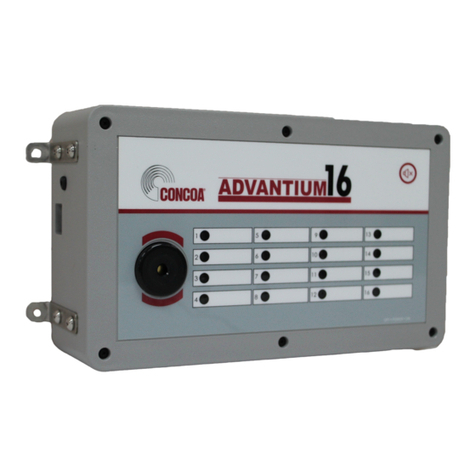
Concoa
Concoa Advantium 16 Installation and operating instructions
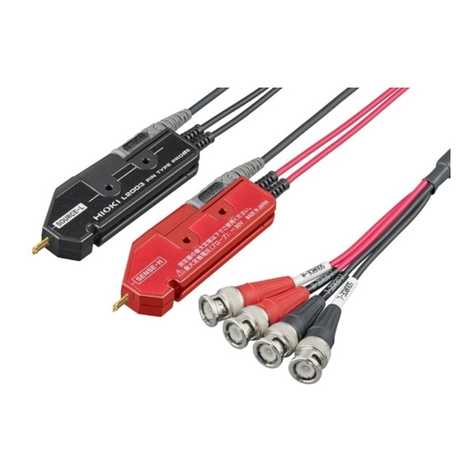
Hioki
Hioki L2003 user manual
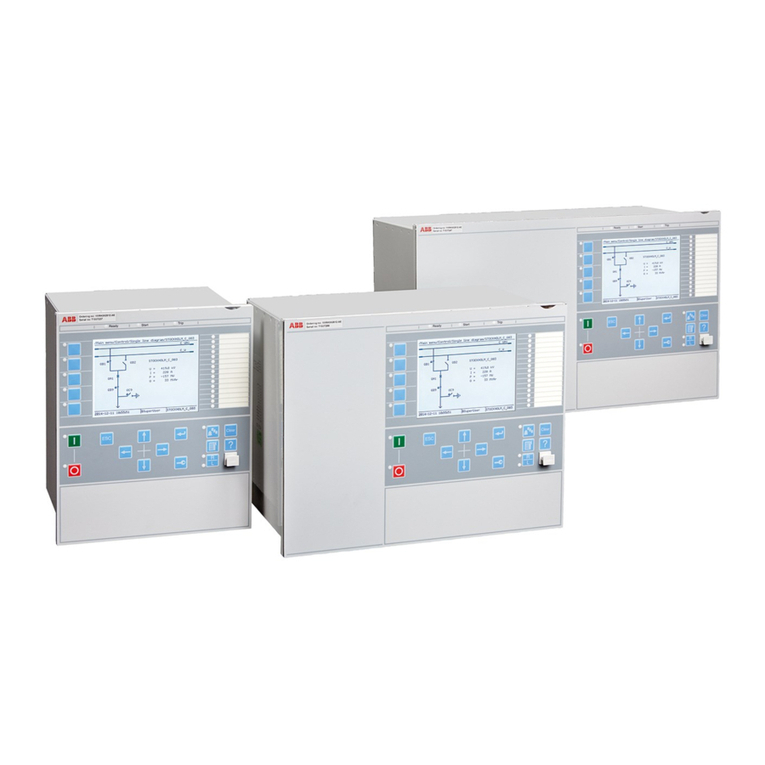
ABB
ABB Relion 670 series Product guide
